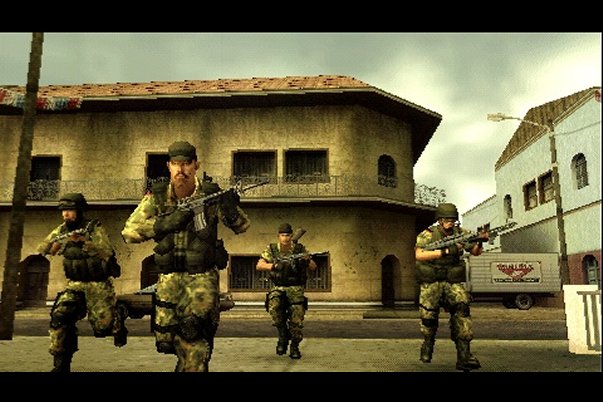SOCOM: Tactical Strike - in the trenches
Squad-based combat gets a strategic makeover - hands-on impressions and fake-gun silliness reveal how it works
For a strategy game, Tactical Strike is pretty easy to pick up and play. Movement is simple - you'll sweep around the landscape with a cursor that looks like four ghosts (these show the position your guys will be in once they move) to choose where you want to go, and ordering your SEALs to attack an enemy is as simple as pointing the camera at them and hitting X. Grenades, meanwhile, are familiar - you'll be presented with an arc that shows where they'll fall - but as an added benefit, you can distract your enemies from the grenade with suppressing fire.
For a strategy game, Tactical Strike is pretty easy to pick up and play. Movement is simple - you'll sweep around the landscape with a cursor that looks like four ghosts (these show the position your guys will be in once they move) to choose where you want to go, and ordering your SEALs to attack an enemy is as simple as pointing the camera at them and hitting X. Grenades, meanwhile, are familiar - you'll be presented with an arc that shows where they'll fall - but as an added benefit, you can distract your enemies from the grenade with suppressing fire.

Your viewpoint is limited to what your SEALs can see, but you can switch your perspective between individuals if you, say, wanted to send one ahead to scout quietly, or move one to higher ground to get a bird's-eye view of the action. More complex stuff - hacking computers, blowing up target vehicles, stuff like that - is normally handled with context-sensitive commands. Just get close enough to whatever it is you want to interact with, and you'll have that option.
Part of the beauty of Tactical Strike - or at least the parts we played during the event - is that there's really no single right way to tackle a situation. Your troops can go in stealthily and methodically, with one two-man team covering the other as each one cautiously creeps forward. You can run around with guns blazing, which will most likely get you killed, or you can go with a less-subtle-but-still-safer approach, like calling in an airstrike you bought pre-mission to soften up your enemies. You can even pick from different starting points in each mission, depending on which goal you'd like to accomplish first. As long as you get the job done and everyone leaves alive, the mission will be counted a success.
Your viewpoint is limited to what your SEALs can see, but you can switch your perspective between individuals if you, say, wanted to send one ahead to scout quietly, or move one to higher ground to get a bird's-eye view of the action. More complex stuff - hacking computers, blowing up target vehicles, stuff like that - is normally handled with context-sensitive commands. Just get close enough to whatever it is you want to interact with, and you'll have that option.
Part of the beauty of Tactical Strike - or at least the parts we played during the event - is that there's really no single right way to tackle a situation. Your troops can go in stealthily and methodically, with one two-man team covering the other as each one cautiously creeps forward. You can run around with guns blazing, which will most likely get you killed, or you can go with a less-subtle-but-still-safer approach, like calling in an airstrike you bought pre-mission to soften up your enemies. You can even pick from different starting points in each mission, depending on which goal you'd like to accomplish first. As long as you get the job done and everyone leaves alive, the mission will be counted a success.
Weekly digests, tales from the communities you love, and more



